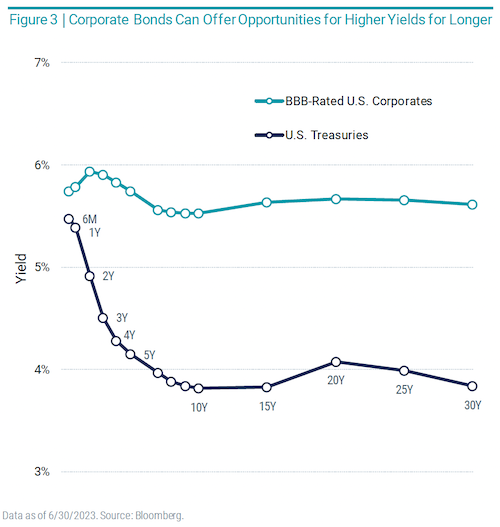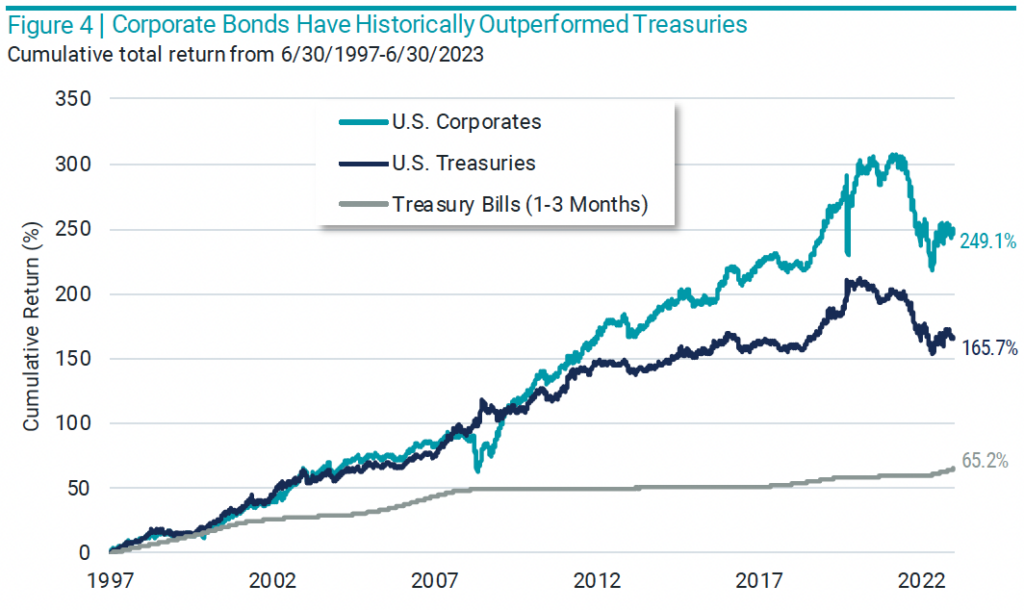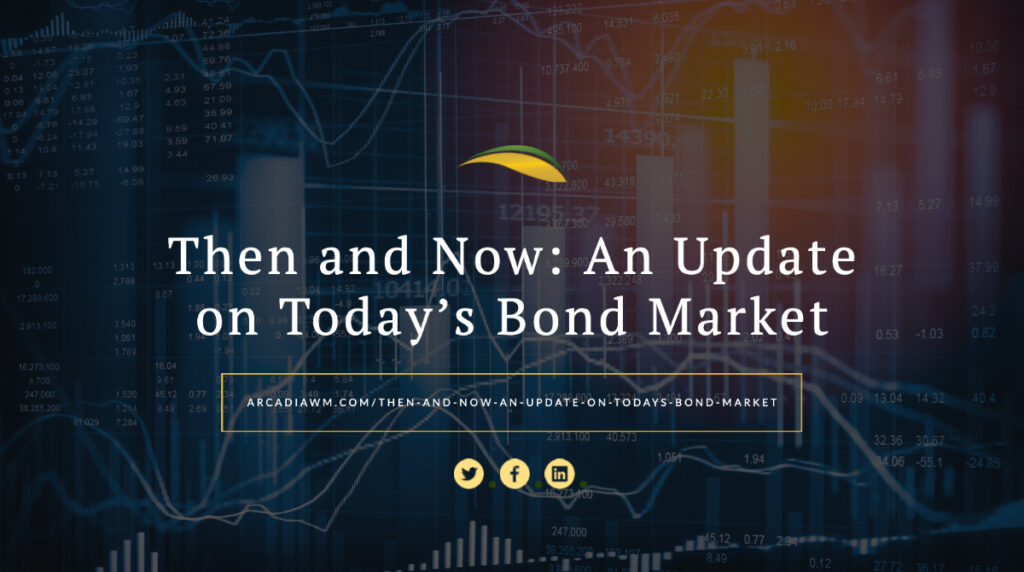Think back to this time last year. Inflation was soaring to a 40-year high of 9.1%. The Federal Reserve (Fed) had just made its third-consecutive rate hike, raising the federal funds rate by 0.75% for the first time in more than 25 years. The S&P 500 Index was down just shy of 20% — the index’s worst 6-month start to a year since 1970.
At the same time, the U.S. bond market, measured by the Bloomberg U.S. Aggregate Bond Index, was down more than 10%. Calls for an impending recession were a dime a dozen. Put simply, these were tough times for many investors’ portfolios.
Oh, how times have changed. The market and economic statistics in Figure 1 help paint the picture. The stock and bond markets have turned around. Inflation has cooled. Some inflation measures using 12-month averages may even overstate current inflation given the rate of price increases has been coming down recently.
An estimate of annualized inflation based on the most recent quarter from the Federal Reserve Bank of Cleveland puts the current Consumer Price Index (CPI) at 3%, nearing the Fed’s 2% target. Economic growth also appears strong. And while the Fed has been clear that more rate hikes may come this year, there are many signs that the period of rising rates, or at least significantly rising rates, may be ending.
So, what are bond investors to make of this? We offer a few considerations for allocating to bonds in today’s market.
Risk-Free Might not Be Without Risk
U.S. Treasury bonds are typically considered risk-free investments. Figure 2 shows the current U.S. Treasury yield curve — a plot of interest rates across Treasuries maturing at different periods —compared to a year ago. We can see that:
- Across the board, yields are higher today than before.
- Investors can earn much higher yields at very short maturities (e.g., Treasuries maturing in three months) versus longer maturities (e.g., Treasuries maturing in 10 or 20 years).

One potential takeaway is to see short-term Treasuries (T-Bills) as a solid investment with a yield of more than 5% and the backing of the U.S. government. In addition, the prices of shorter-term, lower-duration bonds generally don’t fluctuate meaningfully as rates rise. So, why not allocate one’s bond portfolio exclusively to T-Bills? Or maybe all of one’s portfolio to avoid the potential volatility of stocks?
There are a few considerations. First, the goal of the portfolio matters. T-Bills may be better suited for investors seeking extreme stability within their portfolio than for investors aiming for growth (more to come on this). Second, investors must contemplate reinvestment risk. If rates fall before these short-term bonds mature, buying new bonds may not produce the same level of return that an investor could lock in for longer with an intermediate bond today.
It may also mean forgoing the potential price appreciation from falling bond yields that longer-duration bonds may realize (bond prices rise as rates fall). These are important considerations for investors who do not need portfolios with high stability but have chosen to shorten the duration of their fixed-income allocations.
Looking Beyond U.S. Treasuries Can Make a Difference
What are the options for investors seeking moderate or more aggressive growth? In a word, diversification. Looking beyond Treasuries may provide diversification across issuers, the opportunity to increase yield, and greater potential for price appreciation if rates fall.
We present a current example in Figure 3 by comparing the BBB-rated U.S. corporate bond yield curve with the U.S. Treasury yield curve. Two things stand out.
- BBB corporates offer higher yields than Treasuries across all maturities, reflecting in part differences in credit risk (more to come on this, too).
- Unlike the sharply inverted Treasury curve, the BBB corporate curve is relatively flat.

As a result, investors can earn higher yields on longer-dated BBB corporates than Treasuries of the same maturity. This provides an opportunity to increase duration and lock in higher rates for longer than could be achieved today if the opportunity set were only Treasuries.
This doesn’t mean investors have to choose one or the other. Various mixes of bonds across multiple yield curves can offer both the potential benefits of issuer diversification as well as opportunities to address different investor goals (e.g., different aggregate duration profiles).
To offer a little more context on the role of corporate bonds in fixed-income allocations designed for growth, consider the long-term returns of U.S. corporate bonds versus T-Bills and the broader U.S. Treasury market shown in Figure 4.

And, while corporate bonds are expected to carry a higher risk of default than Treasuries, it’s important to recognize that default rates have historically been low among investment-grade corporate bonds (those rated AAA to BBB). Default rates have been higher among high-yield bonds (those rated BB and below). See Figure 5.

As with any investment, considering diversification levels of the strategy and how bonds are selected and weighted within the portfolio can have a meaningful impact on its expected performance. We believe strategies should look beyond just-stated credit ratings and the level of outstanding debt an issuer has (as many indexes do).
Trying to Time Rate Cuts from the Fed May Fall Flat
Finally, we think investors should consider that attempting to precisely time interest-rate changes is, at best, a difficult game to play. Consider bond investors who shortened duration when the Fed was raising rates intending to extend duration once the Fed changed course. The challenge is that the market is forward-looking, and bond prices generally reflect expectations of the market each day.
We see evidence of this in Figure 6, which shows changes in the federal funds rate and the five-year Treasury yield. The Treasury yield (teal line) fell in 2018, and the Fed subsequently lowered rates in 2019 (dark blue line). Similarly, the Treasury yield began climbing in 2021, and the federal funds rate followed suit in 2022.

The takeaway is that attempting to benefit from increasing duration in one’s fixed income portfolio after a Fed decision to lower rates may result in missing the boat. The market typically leads these types of announcements.
We believe a better course of action for investors is to allocate to a mix of bonds at a duration and level of credit quality that makes sense for their long-term goals and make small adjustments as goals and circumstances change. For investors who have shortened duration in the face of uncertain markets or perceived opportunities that have arisen from aggressive Fed action, we think it’s worth considering whether the allocation they have today fits their goals for tomorrow.
Download a PDF of this article
Download the July 2023 Market Review
This article was provided by Avantis Investors and we have been given permission to share this information with our clients and potential clients.






